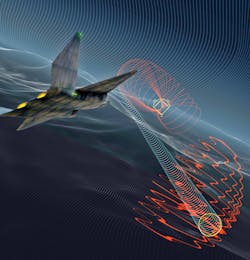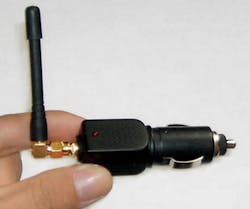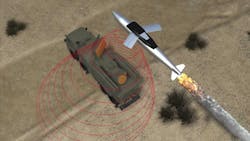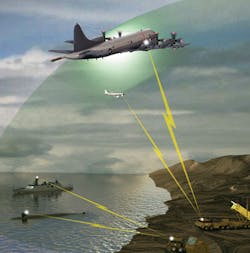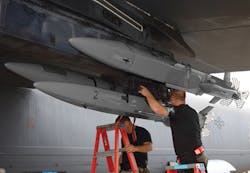Today's battle for the electromagnetic spectrum
U.S. and allied military forces are working on new electronic warfare, cyber warfare, spectrum warfare, and information warfare systems to seize and hold control of communications, radar, and other important sensors.
By J.R. Wilson
Cyber warfare, information warfare, electronic warfare (EW), spectrum warfare, electromagnetic maneuver warfare. Those are only some of the names by which U.S. military experts describe their offensive and defensive use of the electromagnetic spectrum.
Some believe it all should be combined under just one term - Spectrum Warfare or Electromagnetic Maneuver Warfare. Its label, however, is not nearly so important as recognizing the new and rapidly evolving reality of this complex global environment, according to former Chief of Naval Operations retired Adm. Jonathan Greenert.
"The electromagnetic spectrum is an essential - and invisible - part of modern life [military and civilian]. Our military forces use wireless computer networks to coordinate operations and order supplies, use radars and sensors to locate each other and the enemy, and use electronic jammers to blind enemy radars or disrupt their communications," Greenert says. "With wireless routers or satellites part of almost every computer network, cyberspace, and the electromagnetic spectrum now form one continuous environment."
Spectrum warfare is just as important as any other traditional domain of war, Greenert insists. "This environment is so fundamental to naval operations - and so critical to our national interests - that we must treat it on par with our traditional domains of land, sea, air, and space," Greenert says. "In fact, future conflicts will not be won simply by using the electromagnetic spectrum and cyberspace; they will be won within the electromagnetic spectrum and cyberspace. This will require changes to our operating concepts, military systems, and - most importantly - a new way of thinking in our Navy."
Dino Mensa, chief engineer for electromagnetic spectrum dominance/electromagnetic maneuver warfare at the Naval Air Warfare Center-Weapons Division at Point Mugu, Calif., says the nature of that environment and the technologies being developed to operate safely within it will require multifunction and multimission systems.
"Increasingly, as we move forward, the lines between offense and defense are blurring," Mensa says. "To be effective in defense, you need to look to offensive capabilities to disrupt the enemy's ability to understand what is coming in. So we are moving away from a single box aboard a single platform to a more holistic mission look incorporating both offense and defense to get the job done. Still, there remain operational requirements differences between the services, he points out.
"My perception is the Navy is operating in the large, very capable multimission platform mode," Mensa says. He uses the F-35 Joint Strike Fighter (JSF) and the Next-Generation Jammer (NGJ) as multi-billion-dollar programs taking on the world. Other services, such as the U.S. Marine Corps, focus more on modular, reprogrammable, rapidly deployable, reconfigurable system payloads for specific missions; these mission-specific systems solve all EW issues.
Role of commercial technology
EW once largely was a U.S. domain, as evidenced by such archaic terms as information dominance. For the last 25 years or so, however, military-specific spectrum research has been dwarfed by the commercial telecommunications industry and the global proliferation of the now-ubiquitous smartphone. That followed and further spurred commercial dominance in the evolution of faster, smaller, cheaper computer processors, memory, displays, and cameras.
As a result, it became possible for any nation or terrorist group, regardless of size or military budget, to challenge the U.S. in various aspects of EW by developing or buying inexpensive GPS jammers. Without GPS, America would be in danger of losing the edge provided by its successful precision-guided munitions.
"Right now, we're at a major juncture in EW. The proliferation of commercial technology in the telecom world has really accelerated everybody's capabilities. In the 1990s and before, the U.S. was dominant in a lot of specialized EW technology. But with the growth of the commercial wireless market, a lot of other countries now have that technology," warns Joshua Niedzwiecki, director of sensor processing & exploitation at BAE Systems Electronic Systems segment in Nashua, N.H.
To counter that, Niedzwiecki adds, the U.S. Department of Defense (DOD) is seeking the help of the defense industry through their "third offset strategy," announced by the Pentagon in November 2014, "to identify and invest in innovative ways to sustain and advance America's military dominance for the 21st Century".
Historically, the first offset essentially was the threat of America's then-dominant nuclear force to counter the Soviet Union's overwhelming advantage in conventional forces in Europe. As the Soviets began to match U.S. nuclear power, a second offset strategy was devised, calling on the U.S. Defense Advanced Research Projects Agency (DARPA) to help integrate all promising new non-nuclear military technologies into a system-of-systems for joint-force deep attack.
Now the advantages of that strategy also are eroding in the face of several adversaries - from small regional states to near-peer and peer major powers to terrorist organizations with advanced capabilities - and easy access to advanced, commercially developed, technologies.
As a result, a host of new terms and innovations, many that seem to come straight from the pages of science fiction, are moving toward center stage in the next evolution of EW.
Cognitive EW
"Cognitive EW is one area in which we are involved in that. It really is merging a lot of advances in artificial intelligence (AI) and machine learning technology, allowing the use of massive amounts of data. DOD is looking at how to leverage that to give our weapons systems an advantage," says BAE Systems' Niedzwiecki. "One of the things my group does, focusing on processing and AI, with expertise in physics, signals processing, AI and machine learning, is research to make our sensors smarter across the board, including cognitive EW as part of the third offset strategy.
"As you go into an area the threat now, because they can change signal structure and quickly adapt frequencies, is you don't have a lot of prior knowledge to draw from," Niedzwiecki continues. "Cognitive EW is trying to be smarter, putting that intel into the sensor, and allowing the EW system to adapt, on the fly, in real time during the mission, based on what it is observing and how well it is performing. For example, if you see a radar threat with characteristics you've never seen before and try to jam it, cognitive EW measures how effective you are in keeping that radar from seeing you. And it remembers what works so you can use that same technology the next time you see it."
Larry Rexford, EW strategy & marketing manager at Rockwell Collins in Cedar Rapids, Iowa, has been involved in electronic warfare for 35 years, the first 25 as an Air Force officer, including EW director in the Pentagon Requirements Directorate. In his estimation, the state-of-the-art in EW is the systems deployed on U.S. 5th generation fighters - Lockheed Martin's F-22 Raptor and F-35 Lightning II - and the data collection and processing capabilities of the Boeing RC-135 Rivet Joint reconnaissance aircraft.
Only the Air Force flies the F-22, however, and that aircraft no longer is in production. The oft-delayed F-35 has yet to achieve full operational capability and deployment.
"Internationally, coalition collection capabilities are not on par with the RC-135, except the U.K., which now has that platform, so [our allies] rely on support from the U.S. in that mission," Rexford says. For example, there are two vacant EW officer positions on the NATO staff. Outside of Tier 1 nations, such as the U.K. and Australia, which is buying the Growler [Boeing E/A-18G electronic attack aircraft], no one is really investing in this.
Capabilities of adversaries
"In terms of potential adversaries, Russia integrated EW attack capabilities into air maneuver elements and were able to create huge advantages against Ukraine," Rexford continues. "By doing that, they disrupted communications and situational awareness to an extent the Ukrainian military could not act as quickly as Russia could pivot."
The Chinese also have advanced EW capabilities to confront U.S. forces. "You hear more about China in terms of cyber threats," Rexford says. "The Chinese always play a long game, geopolitically. I think they have developed airborne EW capability, but haven't employed it as the Russians did. I know they have collection capability and probably attack, but I don't know if they have integrated those into operations."
Rexford describes himself as a "traditionalist" in the warfighting domain. "You have to be able to sense, protect yourself in the electromagnetic spectrum, and attack to achieve effects - degrade, deny, even destroy. When you execute warfare in the electromagnetic spectrum effectively, you have effects in air, land, and naval applications. There are new requirements. On the collection side, spread spectrum signals - the new AESA radars and lower power radars such as maritime surveillance - are creating a requirements pull for wide instantaneous bandwidth capability.
"We're also seeing requirements for more autonomous capabilities. Cognitive and self-learning capa- bilities aren't fielded yet, but are popping up in some new programs," Rexford says. "If you are looking at an adversary using systems that can change frequencies, you're always trying to catch up. So we need to collect the signals, but also have cognitive, self-learning systems that can identify that and then, on the fly, check its own records to see what is the best way to adapt to those. On the attack side, you see a corresponding requirement to self-learn and self-apply."
DOD, with its third offset strategy, is responding to not only Russian EW integration successes and Chinese long-term electromagnetic strategies, but also to the proliferation of various types and levels of EW offensive and defensive capabilities to second and third tier nations and terrorist organizations.
Electronic warfare proliferation
In June, for example, the Air Force Life Cycle Management Center awarded a four-year, $118.5 million sole-source contract to Raytheon Missile Systems in Tucson, Ariz., for an additional lot of Miniature Air-Launched Decoy Jammers (MALD-J), which are small unmanned aircraft that jam enemy radar while spoofing the characteristics of much larger U.S. and allied aircraft. The goal is to force enemy missile batteries to fire ground-to-air missiles at the wrong targets, thus clearing a path for real manned attack aircraft when those enemy missiles are depleted.
At West Point, Army cadets are being trained in the use of inexpensive "cyber rifles" to shoot down low-flying commercial unmanned aerial vehicles (UAVs), such as those Russia used against Ukraine. While current prototypes only are useful against specific UAVs, the Army Cyber Institute is working on handheld weapons for use against a wide range of UAVs - and possibly other close-by electronic targets.
The 2015 DOD Cyber Strategy is clear about the threat: "During a conflict, the Defense Department assumes that a potential adversary will seek to target U.S. or allied critical infrastructure and military networks to gain a strategic advantage."
In a recent online event hosted by Federal News Radio, Maj. Gen. Paul Nakasone, Commander of CYBERCOM's Cyber National Mission Force, explained the U.S. strategy to counter this growing threat: "We need to better integrate our forces into the planning and execution of operations across the Department of Defense, to build even stronger partnerships across the U.S. government, with allies and industry."
The lack of integration, Rexford maintains, is a key problem to the future of U.S. electronic warfare.
"You have to integrate and we haven't done that. So it's not an inability to create technology, it just goes back to the lack of advocacy, which reduces funding. That dynamic is starting to change because people in Congress are looking at what happened in Ukraine and are asking if we're protected against what the Russians did there, especially if they do the same thing in Poland, for example. So the capability exists, not just current but future generations, out to 2025."
A major part of Nakasone's partnership concept is finding ways to combine and adapt rapidly evolving commercial technologies to meet ever-changing and growing military requirements, preferably in ways it would be extremely difficult for potential adversaries to mimic or counter.
The role of unmanned systems
"I see a drive and need to move away from preplanned mission execution and toward smart unmanned platforms that can make decisions on the fly. Whether there would be a human in the loop would depend on the time scale of what needs to be done," the Naval Air Warfare Center's Mensa says. "There are revolutionary folks who say we need to go all autonomous, but the evolutionary camp says we're not ready to relinquish control. I think approaches are on the table."
Machine learning and cognitive artificial intelligence will be keys to the autonomous dream, Mensa says. "The first step is how do we capture what the EW experts do about attacking threats based on the waveform information we are seeing. That's the cognitive approach and machine learning is the enabler. We want to use as much of the electromagnetic spectrum as possible, so there is a hunger to open new areas of spectrum to operate in, to get away from contested environments, but also to provide more ambiguity as to where we're operating."
The only constant in future airborne EW technology is the lack of constant. The market faces rapid advances in commercial technology driven largely by the smartphone market, the continuation of Moore's Law, new materials and power systems, and faster, smaller, more capable processors. These factors are pushing the merging of electronic warfare, spectrum warfare, cyber warfare, and information warfare into becoming a full and central part of future combat.
"I do see the trend of evolving into a centerpiece," Mensa says. "Spectrum domination and the ability to project our will across swaths of spectrum is a means to an end to achieving commander's intent. So the role of EW becomes more and more central. I also see an increased focus on EW to protect and enable our kinetic capabilities - not just launch missiles, but make sure they reach their targets. EW is a key enabler in that fight."
For that enabler to become key, however, also requires major changes in how the U.S. government and the defense industry change how they develop, acquire, deploy, train, and employ future EW, relative to what U.S. adversaries are doing.
Military leaders share a concern that potential U.S. adversaries are able to observe, orient, decide, and act (OODA) more quickly than U.S. forces can. That means retooling to respond to warfighter needs quickly, "and perhaps turn it around to a speed-to-fleet concept," Mensa says. "It's a challenge because we're used to working programs of record and toward milestones, but to meet the new threats, we need to respond much more quickly."
Worst-case scenarios
Military planners typically assume the worst possible scenarios. "At the Warfare Center, we assume the enemy is 20 feet tall because we have an incomplete knowledge of their capabilities and how integrated their overall warfighting capability may be. So we have to operate under the assumption they are our peers and keep pushing forward to tighten time cycles on new solutions and procedures," Mensa says.
"The assumption - and maybe the reality - is it takes us a lot longer to get a new technology ready for fielding. I'm hopeful we're addressing where it makes sense to be cautious and where it makes sense to rapidly field something. We cannot become too risk-averse. In a constrained fiscal environment, we tend to be so afraid to fail we don't take on challenges that might not work. And we cannot do that."
It is not just a matter of evolving new technologies to address new or more complex threats - something that would be impossible under current fiscal constraints. It also means protecting legacy systems such as Link 16 - a military tactical data exchange network used primarily by the U.S. and NATO aircraft, ships, and ground forces to connect in real time for text messages, images, and digital voice.
"One of the things we're looking at quite a bit is how do we take some of our legacy systems and upgrade them to be more capable," says Niedzwiecki of BAE Systems. "For example, Link 16 is a radio waveform designed and built in the 1970s but still the primary command and control and datalink system and a lot of what we're doing is designed to protect that."
The digital nature of today's military radios could be a key factor in upgrading Link 16 and other military radio networks. "Because our radios today are reprogrammable, we can better protect that investment," Niedzwiecki says. "If you want to design, build, and field an entire new radio system from scratch, that's a multi-billion-dollar effort due to all the interoperability, fielding onto platforms. So upgrading existing systems with better intel is one way to do that affordably."
Niedzwiecki also identifies evolving adaptive threats as one of the most significant challenges facing the U.S. Navy and Air Force, particularly in Eastern Europe and Asia.
Adaptive threats
"The operating environments differ, but what is consistent for any mission is it is all about keeping an expensive platform survivable, maintaining its capabilities, and allowing it to operate with freedom of action and maneuver," Niedzwiecki continues. "EW is becoming more and more a common feature on all platforms, not just on dedicated systems."
Electronic warfare also may be an increasingly more important element of improving the survivability of planes, ships, and land vehicles.
"It's all about advancing capability to allow our platforms to operate in more highly contested environments where the spectrum is cluttered with a lot more friendly and enemy signals and being able to sort all that electromagnetic soup out and make sure our systems are able to communicate and sense and combat enemy radar," Niedzwiecki says.
Airborne EW traditionally has been the purview of manned aircraft. As such, plans to place EW capabilities on all future and legacy platforms means manned defense and attack will remain strong. Still, major advances in UAV types and capabilities during 15 years of war in Southwest Asia and plans to increase their presence aboard Navy ships means future adversaries will face thousands of small deep attack and swarming flying EW robots.
In contested environments, "large aircraft become aluminum confetti very quickly, so you have to stand off even though the collection range requirements haven't changed," says Rockwell Collins' Rexford. "The MALD-J, which was my program in the Pentagon, helps disrupt the enemy's integrated defense system and I think you will see more of those in the future. For sense and attack, I think you will see UAVs becoming more and more important."
Also of importance will be new hardware and software architectures for electronic warfare systems of the future. "Moore's Law is allowing for lower cost, more frequency-agile radars, but our processes in the U.S. are still tied to hardware moving to software," Rexford says. "Realistically, the only way to get at the problem of counter-counter is to have a similar technology cycle, integrated machine learning, and the ability to use and apply AI in a cognitive way that lets you detect, analyze and react on the fly."
The U.S. EW capability has suffered from decades of adversaries with little or minimal EW capabilities and incapable of challenging U.S. air superiority. Russia, China, and other potential future adversaries, however, used that time to close the gap and achieve near-peer capability in EW, such as Russia's integration of technologies - something the U.S. still has not accomplished.
Officials say American forces also still lack training in a near-peer EW environment, integrating spectrum maneuver with air and land forces. Which is another arg ument some put forward to support merging electronic warfare, cyber warfare, and information warfare under the unified rubric of spectrum warfare.
"As technology changes, the dynamic changes in warfare, as does the concept of operations and deployment," Rexford says. "One thing that has to change is the use of spectrum warfare to make it work. In the past, you dropped a bomb, saw a hole, and considered it a success. But in EW, if you deploy a weapon and a signal goes away, you don't know if you destroyed it or the enemy simply shut it down.
"We have to integrate spectrum warfare with maneuver warfare, train that way, update doctrine to capture that construct - all that has to be done to win the spectrum war in the future - and, ultimately, in a near-peer environment, the war itself," Rexford says. "If you don't win the spectrum war, you don't win the war. And that's not a good position to be in."
